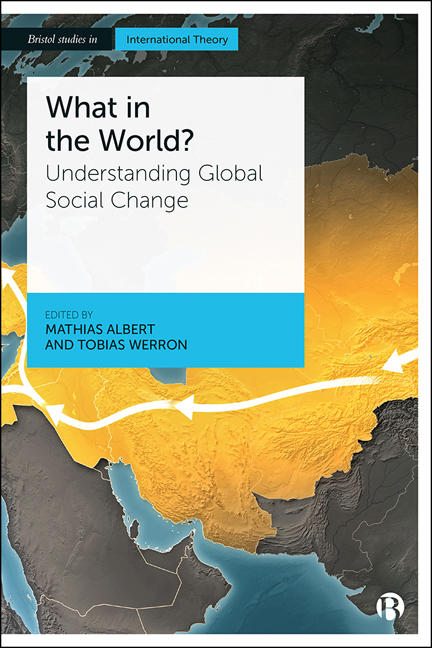Book contents
- Frontmatter
- Contents
- List of Figures and Tables
- Notes on Contributors
- Acknowledgements
- 1 Introduction: World Society and Its Histories – The Sociology and Global History of Global Social Change
- 2 Every Epoch, Time Frame or Date that Is Solid Melts into Air. Does It? The Entanglements of Global History and World Society
- 3 Periodization in Global History: The Productive Power of Comparing
- 4 Communication, Differentiation and the Evolution of World Society
- 5 Field Theory and Global Transformations in the Long Twentieth Century
- 6 Organization(s) of the World
- 7 Particularly Universal Encounters: Ethnographic Explorations into a Laboratory of World Society
- 8 From the First Sino-Roman War (That Never Happened) to Modern International-cum-Imperial Relations: Observing International Politics from an Evolution Theory Perspective
- 9 Nationalism as a Global Institution: A Historical-Sociological View
- 10 States and Markets: A Global Historical Sociology of Capitalist Governance
- 11 The Impact of Communications in Global History
- 12 The ‘Long Twentieth Century’ and the Making of World Trade Law
- 13 Third-Party Actors, Transparency and Global Military Affairs
- 14 Technical Internationalism and Global Social Change: A Critical Look at the Historiography of the United Nations
- References
- Index
11 - The Impact of Communications in Global History
Published online by Cambridge University Press: 22 December 2021
- Frontmatter
- Contents
- List of Figures and Tables
- Notes on Contributors
- Acknowledgements
- 1 Introduction: World Society and Its Histories – The Sociology and Global History of Global Social Change
- 2 Every Epoch, Time Frame or Date that Is Solid Melts into Air. Does It? The Entanglements of Global History and World Society
- 3 Periodization in Global History: The Productive Power of Comparing
- 4 Communication, Differentiation and the Evolution of World Society
- 5 Field Theory and Global Transformations in the Long Twentieth Century
- 6 Organization(s) of the World
- 7 Particularly Universal Encounters: Ethnographic Explorations into a Laboratory of World Society
- 8 From the First Sino-Roman War (That Never Happened) to Modern International-cum-Imperial Relations: Observing International Politics from an Evolution Theory Perspective
- 9 Nationalism as a Global Institution: A Historical-Sociological View
- 10 States and Markets: A Global Historical Sociology of Capitalist Governance
- 11 The Impact of Communications in Global History
- 12 The ‘Long Twentieth Century’ and the Making of World Trade Law
- 13 Third-Party Actors, Transparency and Global Military Affairs
- 14 Technical Internationalism and Global Social Change: A Critical Look at the Historiography of the United Nations
- References
- Index
Summary
Introduction
Every global history at least pays lip service to communications and transportation revolutions. Jurgen Osterhammel noted in his magisterial work of nineteenth-century global history that telegraphy and railways represented a ‘fundamental break’ with the past (Osterhammel, 2009: 126). These types of claims raise many questions (on periodizing, see Epple, Chapter 3 in this volume). What type of break – political, economic, cultural, technological, social? How do we measure a ‘before’ and ‘after’? What may have stayed the same? Why do historians claim these effects for telegraphy, but not other communications technologies like wireless?
Histories of the world economy similarly recognize the importance of communications. Steven Topik and Allan Wells described telegraphy as one of the ‘sinews of the world economy’ in their contribution on global commodity chains to A World Connecting, a volume on various aspects of world history from 1870 to 1945 that totals over 1,000 pages and is one of six similarly sized books discussing world history from antiquity to the present (Topik and Wells, 2014: 113). Global commodity chains in staples like wheat and stimulants like tobacco could only travel along sinews that emerged in the nineteenth century to tie together the world economy. Topik and Wells singled out legal frameworks, monetary standards, energy sources, and various forms of transportation and communication infrastructure (shipping, railroads, canals, telegraphy) as the key sinews.
Perhaps unwittingly, Topik and Wells used one of the key metaphors of the nineteenth-century global telegraphic system. This portrayed the world as a body with telegraphic nerves wired around it (Otis, 2001). The muscular metaphor of sinews similarly depicts the world as a singular corporeal entity to be controlled and tamed. It implies that global historians often take the ‘taming’ as a precondition for globalization, though that ‘taming’ frequently resulted in violence against colonial populations. Communications systems are not just preconditions for globalization; they are an integral strand of institutionalizing flows across borders and controlling them. They created and were created by the increasing integration of nineteenthcentury international society. They often deepened international connections that had already existed, rather than remaking time and space anew.
- Type
- Chapter
- Information
- What in the World?Understanding Global Social Change, pp. 195 - 210Publisher: Bristol University PressPrint publication year: 2020



